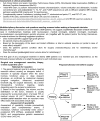Assessment and treatment relevance in elderly glioblastoma patients
- PMID: 24792440
- PMCID: PMC4201066
- DOI: 10.1093/neuonc/nou063
Assessment and treatment relevance in elderly glioblastoma patients
Abstract
Glioblastoma (GBM) is the most common malignant primary brain tumor. Its incidence continues to increase in the elderly because the older segment of the population is growing faster than any other age group. Most clinical studies exclude elderly patients, and "standards of care" do not exist for GBM patients aged >70 years. We review epidemiology, tumor biology/molecular factors, prognostic factors (clinical, imaging data, therapeutics), and their assessments as well as classic and specific endpoints plus recent and ongoing clinical trials for elderly GBM patients. This work includes perspectives and personal opinions on this topic. Although there are no standards of care for elderly GBM patients, we can hypothesize that (i) Karnofsky performance status (KPS), probably after steroid treatment, is one of the most important clinical factors for determining our oncological strategy; (ii) resection is superior to biopsy, at least in selected patients (depending on location of the tumor and associated comorbidities); (iii) specific schedules of radiotherapy yield a modest but significant improvement; (iv) temozolomide has an acceptable tolerance, even when KPS <70, and could be proposed for methylated elderly GBM patients; and (v) the addition of concomitant temozolomide to radiotherapy has not yet been validated but shows promising results in some studies, yet the optimal schedule of radiotherapy remains to be determined. In the future, specific assessments (geriatric, imaging, biology) and use of new endpoints (quality of life and toxicity measures) will aid clinicians in determining the balance of potential benefits and risks of each oncological strategy.
Keywords: assessment; database; elderly; glioblastoma; neuro-oncology.
© The Author(s) 2014. Published by Oxford University Press on behalf of the Society for Neuro-Oncology. All rights reserved. For permissions, please e-mail: journals.permissions@oup.com.
Figures


References
-
- Reardon DA. Treatment of elderly patients with glioblastoma. Lancet Oncol. 2012;13(7):656–657. - PubMed
-
- Holdhoff M, Chamberlain MC. Controversies in the treatment of elderly patients with newly diagnosed glioblastoma. J Natl Compr Canc Netw. 2013;11(9):1165–1173. - PubMed
-
- Stupp R, Mason WP, van den Bent MJ, et al. Radiotherapy plus concomitant and adjuvant temozolomide for glioblastoma. N Engl J Med. 2005;352(10):987–996. - PubMed
Publication types
MeSH terms
LinkOut - more resources
Full Text Sources
Other Literature Sources

